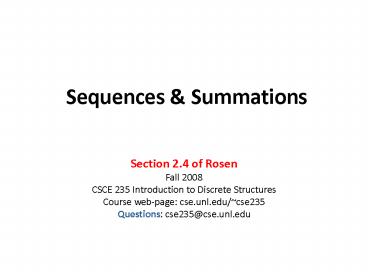Sequences - PowerPoint PPT Presentation
Title:
Sequences
Description:
Table 1 on Page 153 (Rosen) has some useful sequences: ... which can be done in a straightforward manner (although we must be very careful) ... – PowerPoint PPT presentation
Number of Views:23
Avg rating:3.0/5.0
Title: Sequences
1
Sequences Summations
- Section 2.4 of Rosen
- Fall 2008
- CSCE 235 Introduction to Discrete Structures
- Course web-page cse.unl.edu/cse235
- Questions cse235_at_cse.unl.edu
2
Outline
- Although you are (more or less) familiar with
sequences and summations, we give a quick review - Sequences
- Definition, 2 examples
- Progressions Special sequences
- Geometric, arithmetic
- Summations
- Careful when changing lower/upper limits
- Series Sum of the elements of a sequence
- Examples, infinite series, convergence of a
geometric series
3
Sequences
- Definition A sequence is a function from a
subset of integers to a set S. We use the
notation(s) - an ann? ann0?
- Each an is called the nth term of the sequence
- We rely on the context to distinguish between a
sequence and a set, although they are distinct
structures
4
Sequences Example 1
- Consider the sequence
- (1 1/n)nn1 ?
- The terms of the sequence are
- a1 (1 1/1)1 2.00000
- a2 (1 1/2)2 2.25000
- a3 (1 1/3)3 2.37037
- a4 (1 1/4)4 2.44140
- a5 (1 1/5)5 2.48832
- What is this sequence?
- The sequence corresponds to elimn??(1
1/n)nn1 ? e 2.71828..
5
Sequences Example 2
- The sequence hnn1? 1/n
- is known as the harmonic sequence
- The sequence is simply
- 1, 1/2, 1/3, 1/4, 1/5,
- This sequence is particularly intersting because
its summation is divergent - ? n1? (1/n) ?
6
Progressions Geometric
- Definition A geometric progression is a sequence
of the form - a, ar, ar2, ar3, , arn,
- Where
- a?R is called the initial term
- r?R is called the common ratio
- A geometric progression is a discrete analogue of
the exponential function - f(x) arx
7
Geometric Progressions Examples
- A common geometric progression in Computer
Science is - an 1/2n
- with a1 and r1/2
- Give the initial term and the common ratio of
- bn with bn (-1)n
- cn with cn 2(5)n
- dn with dn 6(1/3)n
8
Progressions Arithmetic
- Definition An arithmetric progression is a
sequence of the form - a, ad, a2d, a3d, , and,
- Where
- a?R is called the initial term
- d?R is called the common ratio
- An arithmetic progression is a discrete analogue
of the linear function - f(x) dxa
9
Arithmetic Progressions Examples
- Give the initial term and the common difference
of - sn with sn -1 4n
- tn with sn 7 3n
10
More Examples
- Table 1 on Page 153 (Rosen) has some useful
sequences - n2n1?, n3 n1?, n4 n1?, 2n n1?, 3n
n1?, n! n1?
11
Outline
- Although you are (more or less) familiar with
sequences and summations, we give a quick review - Sequences
- Definition, 2 examples
- Progressions Special sequences
- Geometric, arithmetic
- Summations
- Careful when changing lower/upper limits
- Series Sum of the elements of a sequence
- Examples, infinite series, convergence of a
geometric series
12
Summations (1)
- You should be by now familiar with the summation
notation - ?jmn (aj) am am1 an-1 an
- Here
- j is the index of the summation
- m is the lower limit
- n is the upper limit
- Often times, it is useful to change the
lower/upper limits, which can be done in a
straightforward manner (although we must be very
careful) - ?j1n (aj) ?ion-1 (ai1)
13
Summations (2)
- Sometimes we can express a summation in closed
form, as for geometric series - Theorem For a, r?R, r?0
- Closed form analytical expression using a
bounded number of well-known functions, does not
involved an infinite series or use of recursion
(arn1-a)/(r-1) if r ? 1
?i0n (ari)
(n1)a if r 1
14
Summations (3)
- Double summations often arise when analyzing an
algorithm - ?i1n ?j1i(aj) a1
- a1a2
- a1a2a3
- a1a2a3an
- Summations can also be indexed over elements in a
set - ?s?S f(s)
- Table 2 on Page 157 (Rosen) has very useful
summations. Exercises 2.4.1418 are great
material to practice on.
15
Outline
- Although you are (more or less) familiar with
sequences and summations, we give a quick review - Sequences
- Definition, 2 examples
- Progressions Special sequences
- Geometric, arithmetic
- Summations
- Careful when changing lower/upper limits
- Series Sum of the elements of a sequence
- Examples, infinite series, convergence of a
geometric series
16
Series
- When we take the sum of a sequence, we get a
series - We have already seen a closed form for geometric
series - Some other useful closed forms include the
following - ?iku 1 u-k1, for k?u
- ?i0n i n(n1)/2
- ?i0n (i2) n(n1)(2n1)/6
- ?i0n (ik) ? nk1/(k1)
17
Infinite Series
- Although we will mostly deal with finite series
(i.e., an upper limit of n for fixed integer),
inifinite series are also useful - Consider the following geometric series
- ?n0? (1/2n) 1 1/2 1/4 1/8 converges
to 2 - ?n0? (2n) 1 2 4 8 does not converge
- However note ?n0n (2n) 2n1 1 (a1,r2)
18
Infinite Series Geometric Series
- In fact, we can generalize that fact as follows
- Lemma A geometric series converges if and only
if the absolute value of the common ratio is less
than 1
(arn1-a)/(r-1) if r ? 1
?i0n (ari)
(n1)a if r 1































